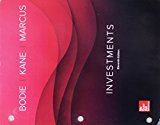
Concept explainers
a
Adequate information:
U.S. market is risky portfolio
Risk-aversion coefficient A=4
Period representing the future expected performance = 1926 to 2015
| Average Annual Returns | S&P 500 Portfolio | |||||
| Period | S&P 500 Portfolio | 1-month T-bills | Risk premium | Standard deviation | Sharpe Ratio | Probability |
| 1926-2015 | 11.67 | 3.58 | 8.10 | 20.48 | 0.40 | -- |
| 1992-2015 | 11.10 | 3.52 | 7.59 | 18.22 | 0.42 | 0.94 |
| 1970-1991 | 10.91 | 7.48 | 3.44 | 16.71 | 0.21 | 0.50 |
| 1949-1969 | 15.35 | 2.28 | 13.08 | 17.66 | 0.74 | 0.24 |
| 1926 -1948 | 9.40 | 1.04 | 8.36 | 27.95 | 0.30 | 0.71 |
To compute: The fraction of portfolio to be allocated to T-bills and Equity.
Introduction:
Risk aversion coefficient: In today’s world, every aspect has a risk factor along with the benefits. When it comes to financial product, then it is obvious to have a risk. To measure such risk relative with its performance, we make use of standard deviation of returns. These are also known as volatility of returns. When a number from 1 (assuming to be lowest risk aversion) to 5 (assuming to be highest risk aversion) is attributed to an investor, this number is further assigned the letter A which is called the risk aversion coefficient.
a
Explanation of Solution
Here, we have to calculate the proportion of Y of the total investment. It is clear that the optimal position y related to a risky asset will be proportional to the risk premium while there is an inverse proportional relationship with that of the variance and degree of risk aversion.
When the entire period 1926-2015 is representing future expected performance, then A=4
By substituting the values, we get
We need to convert the percentages to normal values. After that, we get the equation as :
Or 48.28% when converted to percentages
So, 48.28% have to be allocated to equity
If 100 is assumed to be the total, then
Therefore, 51.72% is to be allocated to T-bills.
So, 48.28% have to be allocated to equity and 51.72% is to be allocated to T-bills.
b
Adequate information:
U.S. market is risky portfolio
Risk-aversion coefficient A=4
Period representing the future expected performance = 1970 to 1991
To compute: The circumstances if period is representing the future expected performance is 1970 to 1991.
Introduction:
Risk aversion coefficient: In today’s world, every aspect has a risk factor along with the benefits. When it comes to financial product, then it is obvious to have a risk. To measure such risk relative with its performance, we make use of standard deviation of returns. These are also known as volatility of returns. When a number from 1 (assuming to be lowest risk aversion) to 5 (assuming to be highest risk aversion) is attributed to an investor, this number is further assigned the letter A which is called the risk aversion coefficient.
b
Explanation of Solution
When the entire period 1970-1991 is representing future expected performance, then A=4
E(rm)-rf=3.44%
sM=16.71%
By substituting the values, we get
We need to convert the percentages to normal values. After that, we get the equation as :
or 30.80% when rounded off and converted to percentages
So, 30.80% have to be allocated to equity
If 100 is assumed to be the total, then
Therefore, 69.20% is to be allocated to T-bills.
So, 30.80% have to be allocated to equity and 69.20% is to be allocated to T-bills.
c
Adequate information:
U.S. market is risky portfolio
Risk-aversion coefficient A=4
Period representing the future expected performance = 1926 to 2015
Period representing the future expected performance = 1970 to 1991
To compute: The analysis of circumstances in both the given periods i.e, 1926-2015 and 1970-1991.
Introduction:
Risk aversion coefficient: In today’s world, every aspect has a risk factor along with the benefits. When it comes to financial product, then it is obvious to have a risk. To measure such risk relative with its performance, we make use of standard deviation of returns. These are also known as volatility of returns. When a number from 1 (assuming to be lowest risk aversion) to 5 (assuming to be highest risk aversion) is attributed to an investor, this number is further assigned the letter A which is called the risk aversion coefficient.
c
Explanation of Solution
It is clear that the risk premium in the period 1926-2015 is 8.10 ; whereas for the period 1970-1991 it is 3.44. So, when we compare both values, we find that the risk premium for the period 1970-1991 is less than the risk premium of the period 1926-2015.
Secondly, the Sharpe ratio for the period 1970-1991 is less and it has higher proportion of T-bills.
The results got from the calculation states that as market risk premium is probable to be less for the period 1926-2015, the market risk is supposed to higher and secondly, since the proportion of T-bills is more for the period 1970-1991, its Sharpe ratio will be less when compared to the period 1926-2015.
Want to see more full solutions like this?
Chapter 6 Solutions
GEN COMBO LOOSELEAF INVESTMENTS; CONNECT ACCESS CARD
 Intermediate Financial Management (MindTap Course...FinanceISBN:9781337395083Author:Eugene F. Brigham, Phillip R. DavesPublisher:Cengage Learning
Intermediate Financial Management (MindTap Course...FinanceISBN:9781337395083Author:Eugene F. Brigham, Phillip R. DavesPublisher:Cengage Learning

